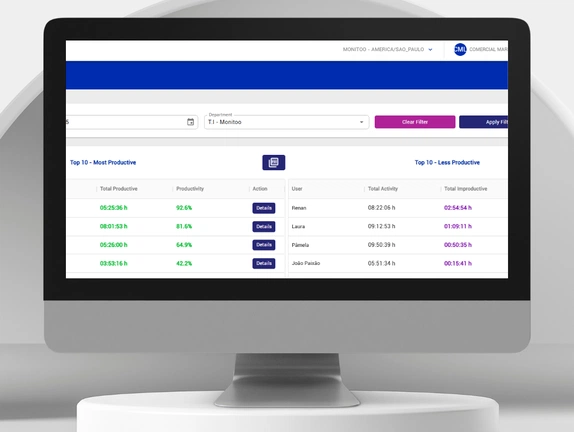Productivity , Efficiency
10 de October de 2025 - 17h10m
ShareIf you took part in Monitoo’s Productivity Challenge on social media — congratulations!
More than just a simple quiz, the goal was to test your knowledge of the key indicators used by high-performance managers to measure results and boost team efficiency.
But if you hesitated while reading the questions — or if you’d like to learn how to apply these concepts in your daily management routine — this post is for you.
In this complete guide, we’ll break down the four questions from the challenge, explaining:
Get ready — by the end, you’ll understand how KPI, OKR, ROI, and NPS connect to form a complete view of productivity, efficiency, and satisfaction — both inside and outside your company.
What does KPI mean?
KPI stands for Key Performance Indicator.
In simple terms, a KPI is a measurable metric used to track progress toward a specific goal.
It translates results into numbers, allowing managers to clearly see what’s working — and what needs adjustment.
Simple example:
If your goal is to increase team productivity, a relevant KPI might be “productive hours per employee per day.”
This data shows how much effective, productive time your team is delivering — and, therefore, how close you are to achieving your goal.
Without indicators, management becomes intuitive — based on perceptions rather than facts.
KPIs bring clarity, precision, and objectivity.
They allow you to:
As Peter Drucker — the father of modern management — once said:
“What gets measured gets improved.”
There are many types of KPIs, depending on the focus of your analysis:
|
Type |
Example |
What It Measures |
|
Operational |
Average task execution time |
Process efficiency |
|
Financial |
Cost per active employee |
Expense control |
|
Productivity |
Productive vs. idle time |
Individual and team performance |
|
Quality |
Rework rate |
Delivery accuracy and efficiency |
Within Monitoo, productivity KPIs stand out.
The platform automatically provides data such as:
All of this is displayed in visual reports and dashboards, helping managers make smarter, evidence-based decisions.
Imagine you want to monitor the KPI “Team Idle Rate.”
With Monitoo, you can set up automatic reports to identify:
These insights help you not only measure but also diagnose causes — and adjust processes with data, not guesswork.
👉 Result: Smarter, performance-driven management.
What does OKR mean?
OKR stands for Objectives and Key Results — a management framework created by Intel and popularized by Google to align teams around clear, measurable goals.
While a KPI measures performance, an OKR defines where you want to go and how you’ll know you’re getting there.
An OKR has two components:
The difference between KPI and OKR
|
KPI |
OKR |
|
Measures ongoing performance |
Defines specific, time-bound goals |
|
Focuses on performance metrics |
Focuses on objectives and results |
|
Shows how you’re doing |
Shows where you’re headed |
|
Example: Idle rate |
Example: Reduce idle time by 20% this quarter |
When setting OKRs, you need concrete data to track progress — and that’s where Monitoo comes in.
With Monitoo, you can:
For instance, if your OKR is “Increase remote team productivity by 15%”, Monitoo shows exactly:
Each data point becomes an insight — and each insight, an actionable improvement.
What does ROI mean?
ROI stands for Return on Investment.
It’s a financial metric that shows how much profit or benefit you gained compared to what you invested.
Simply put — ROI answers the question: Was it worth it?
Basic formula:
ROI=(Profit-Investment)Investment×100
Suppose your company invested $1,000 in implementing a monitoring tool like Monitoo, and after three months:
Applying the formula:
ROI=(2000-1000)1000×100=100%
That means the investment paid for itself — and doubled in value.
While “return” often refers to money, ROI can also measure intangible gains such as:
In all cases, Monitoo provides the data needed to calculate return based on real productivity indicators.
With detailed reports on:
you can compare results before and after new strategies — like training, remote work policies, or process changes.
👉 Outcome: Every decision is based on results, not assumptions.
What does NPS mean?
NPS stands for Net Promoter Score — a customer satisfaction metric.
It measures how likely your customers are to recommend your company to others.
The method is based on one key question:
“On a scale from 0 to 10, how likely are you to recommend our company (or product) to a friend or colleague?”
Based on their answers, customers are classified as:
|
Type |
Score |
Description |
|
Promoters |
9–10 |
Brand advocates; actively recommend you. |
|
Passives |
7–8 |
Satisfied but not enthusiastic. |
|
Detractors |
0–6 |
Unhappy; may harm your reputation. |
Formula:
NPS=% of Promoters-% of Detractors
Scores range from -100 to +100.
The higher the score, the greater the satisfaction.
It might seem unrelated, but there’s a strong connection between internal productivity and customer satisfaction.
Productive teams:
All of this directly influences the customer experience — and the NPS score.
When teams have clear goals (OKRs), performance metrics (KPIs), and a positive ROI, the result is naturally a higher NPS.
Monitoo operates behind the scenes of performance management.
It allows managers to:
These improvements ultimately impact the end customer — even if they don’t see it directly.
Faster processes and better service lead to higher satisfaction — and a stronger brand reputation.
Now that you know the answers to the Productivity Challenge, you’ve learned that:
But the real advantage lies in using these indicators together, with real-time data — not assumptions.
That’s where Monitoo makes the difference.
It provides the insights that feed your KPIs, validate your OKRs, calculate your ROI, and indirectly enhance your NPS.
In short:
Monitoo transforms information into decisions — and decisions into results.
Final Tip
Want to put all this into practice right now?
👉 Request your free Monitoo trial and see how easy it is to track productivity, focus, and performance in real time.

